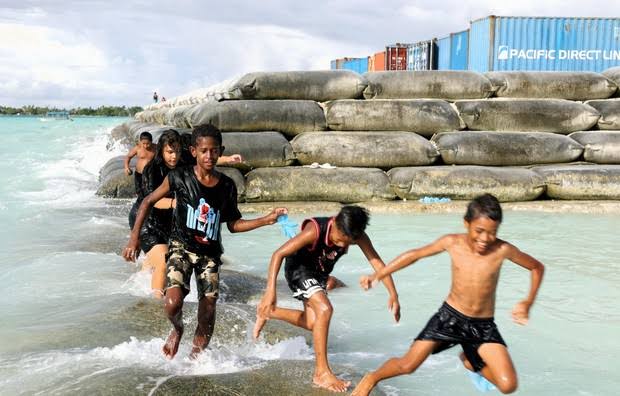Tuvaluans facing forced relocation as rising seas threaten future

This photo taken in December 2024 shows children swimming and playing on sandbags that line the shore of a section of reclaimed land in Funafuti, Tuvalu
The Pacific Island nation of Tuvalu faces the likely prospect of becoming the first country in the world to be uninhabitable due to climate change, as rising sea levels threaten to submerge the archipelago in a matter of decades.
Given this stark reality, Tuvaluans are being forced to consider relocation as the sea continues to encroach upon the islands, making the future of the isolated nation that lies some 1,000 kilometers north of Fiji increasingly uncertain.
Perched at an average height of just 2 meters above sea level, the archipelago of nine low-lying coral atolls has seen a 15-centimeter rise in sea levels over the last 30 years, a rate 1.5 times the global average, according to the Sea Level Change Team at the U.S. National Aeronautics and Space Administration.
By 2050, NASA scientists project that much of the nation’s 26 square km of land and the critical infrastructure on it will be below the average high tide level.
Evidence of the rising sea is clear on the main atoll of Funafuti, home to more than half the nation’s population of 9,600 people. Sections of the island’s main road flood at high tide, leaving locals to dodge large puddles of seawater as they zip past on motorbikes.
For Lilian Vi, a 31-year-old mother of two young boys, the sea level rise is something she notices every day.
“It’s been 31 years I’ve been seeing the sea level rise, and it’s not okay. It’s really scary,” Vi told Kyodo News outside her home in the center of Funafuti, which she shares with her father, cousin and her two sons, Moses, 7, and Carl, 3.
Their home sits behind a section of raised reclaimed land fortified by sandbags positioned to protect against the lapping waves of the lagoon. While the built-up area gives her some peace of mind, Vi questions how long it will last.
“Some of the islets — the sea has been taking up. It’s been eating the islands. It’s going to disappear sometime,” she said.
While Tuvalu’s government is working to secure a future for the archipelago by strengthening its coastline, it has also struck a deal with its Pacific neighbor Australia to provide a migration pathway for up to 280 Tuvaluans a year under an agreement dubbed the “Falepili Union.”
With its small population, Tuvalu could be depopulated in 35 years at that rate. But locals and experts alike suggest a mass migration out of the country is unlikely, due to the strong links between the Tuvaluan people and their homeland.
Carol Farbotko, an expert on Tuvalu and ARC Future Fellow at Griffith University in Australia, said that while most Tuvaluans are “highly aware” of the future risk posed by climate change-fueled sea-level rise, many are choosing to stay in Tuvalu and want to help ensure the long-term future of their island nation.
“The Falepili Union migration pathway is not intended to serve mass relocation, as the key priority for the Tuvaluan government is to invest in adaptation measures to enable Tuvalu to remain habitable,” Farbotko said.
For Vi, however, the pathway represents “a really big opportunity” for the education and future of her children. While many of her relatives have relocated overseas for employment or better access to health care, Vi admits she had never imagined leaving Tuvalu until now.
“I never planned (to migrate) before because I couldn’t leave my country. I love my country,” Vi said. “But due to these changes, I have to think for the future of my family.”
The Tuvalu government expects the Falepili Union visa scheme will begin accepting applications in May, with hopes the first batch of citizens to migrate to Australia will be finalized by mid-year.




